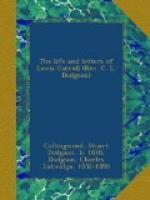The pamphlet ends with an explanation of Lewis Carroll’s method of using a correspondence-book, illustrated by a few imaginary pages from such a compilation, which are very humorous.
[Illustration: Facsimile of programme of “Alice in Wonderland.”]
At the end of the year the “Alice” operetta was again produced at the Globe Theatre, with Miss Isa Bowman as the heroine. “Isa makes a delightful Alice,” Mr. Dodgson writes, “and Emsie [a younger sister] is wonderfully good as Dormouse and as Second Ghost [of an oyster!], when she sings a verse, and dances the Sailor’s Hornpipe.”
[Illustration: “The Mad Tea-Party.” From a photograph by Elliott & Fry.]
The first of an incomplete series, “Curiosa Mathematica,” was published for Mr. Dodgson by Messrs. Macmillan during the year. It was entitled “A New Theory of Parallels,” and any one taking it up for the first time might be tempted to ask, Is the author serious, or is he simply giving us some jeu d’esprit? A closer inspection, however, soon settles the question, and the reader, if mathematics be his hobby, is carried irresistibly along till he reaches the last page.
The object which Mr. Dodgson set himself to accomplish was to prove Euclid I. 32 without assuming the celebrated 12th Axiom, a feat which calls up visions of the “Circle-Squarers.”
The work is divided into two parts: Book I. contains certain Propositions which require no disputable Axiom for their proof, and when once the few Definitions of “amount,” &c., have become familiar it is easy reading. In Book II. the author introduces a new Axiom, or rather “Quasi-Axiom”—for it’s self-evident character is open to dispute. This Axiom is as follows:—
In any Circle the inscribed
equilateral Tetragon (Hexagon in
editions 1st and 2nd) is greater
than any one of the
Segments which lie outside
it.
Assuming the truth of this Axiom, Mr. Dodgson proves a series of Propositions, which lead up to and enable him to accomplish the feat referred to above.
At the end of Book II. he places a proof (so far as finite magnitudes are concerned) of Euclid’s Axiom, preceded by and dependent on the Axiom that “If two homogeneous magnitudes be both of them finite, the lesser may be so multiplied by a finite number as to exceed the greater.” This Axiom, he says, he believes to be assumed by every writer who has attempted to prove Euclid’s 12th Axiom. The proof itself is borrowed, with slight alterations, from Cuthbertson’s “Euclidean Geometry.”
In Appendix I. there is an alternative Axiom which may be substituted for that which introduces Book II., and which will probably commend itself to many minds as being more truly axiomatic. To substitute this, however, involves some additions and alterations, which the author appends.




